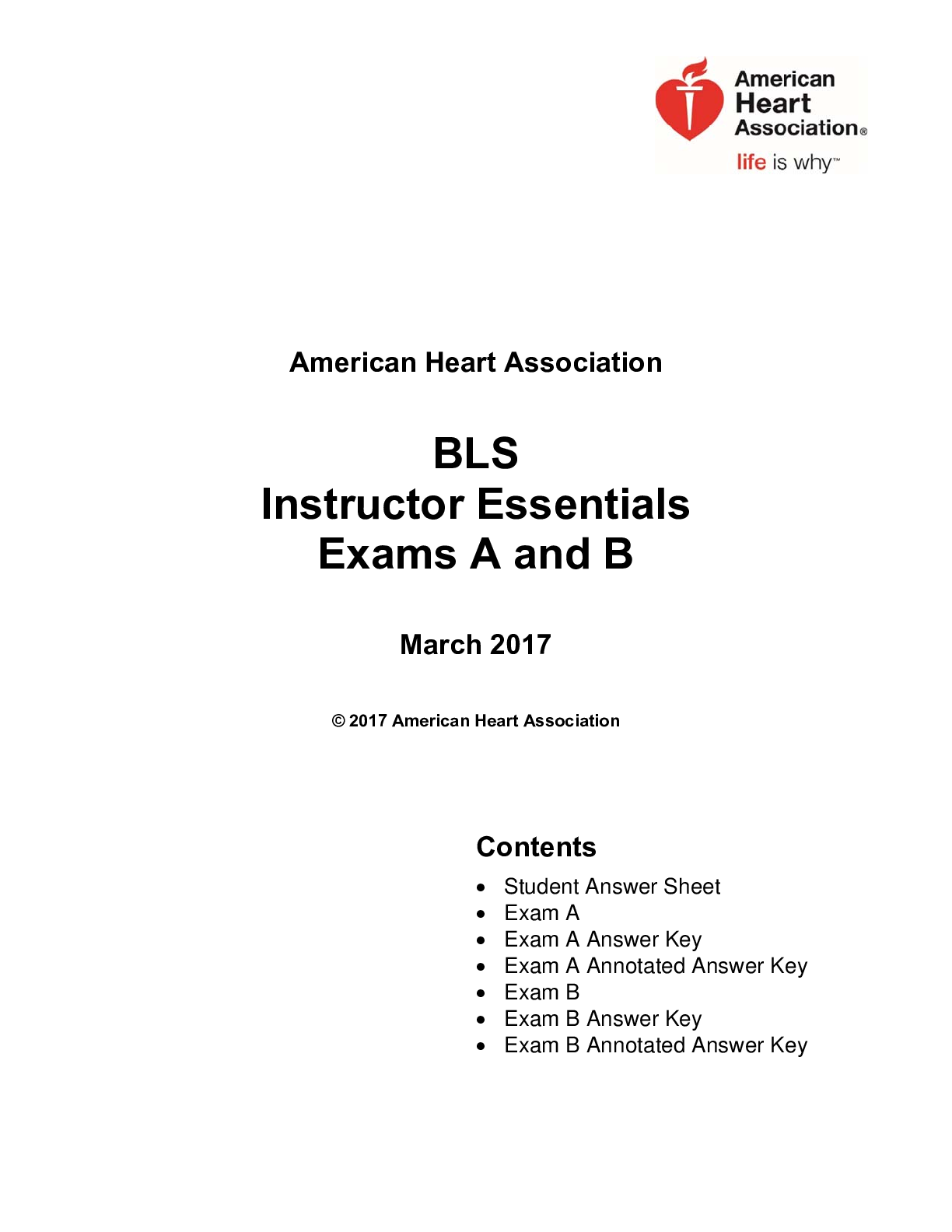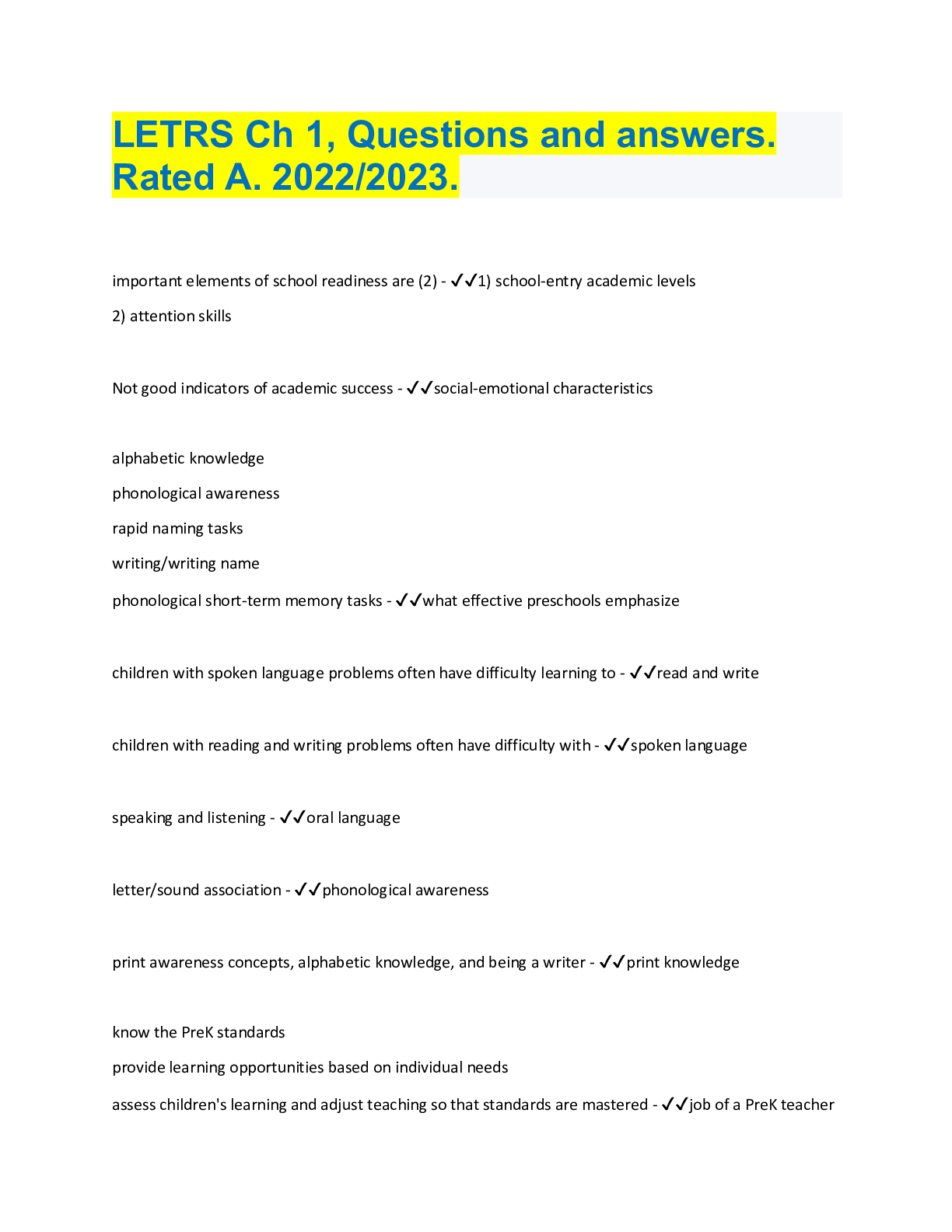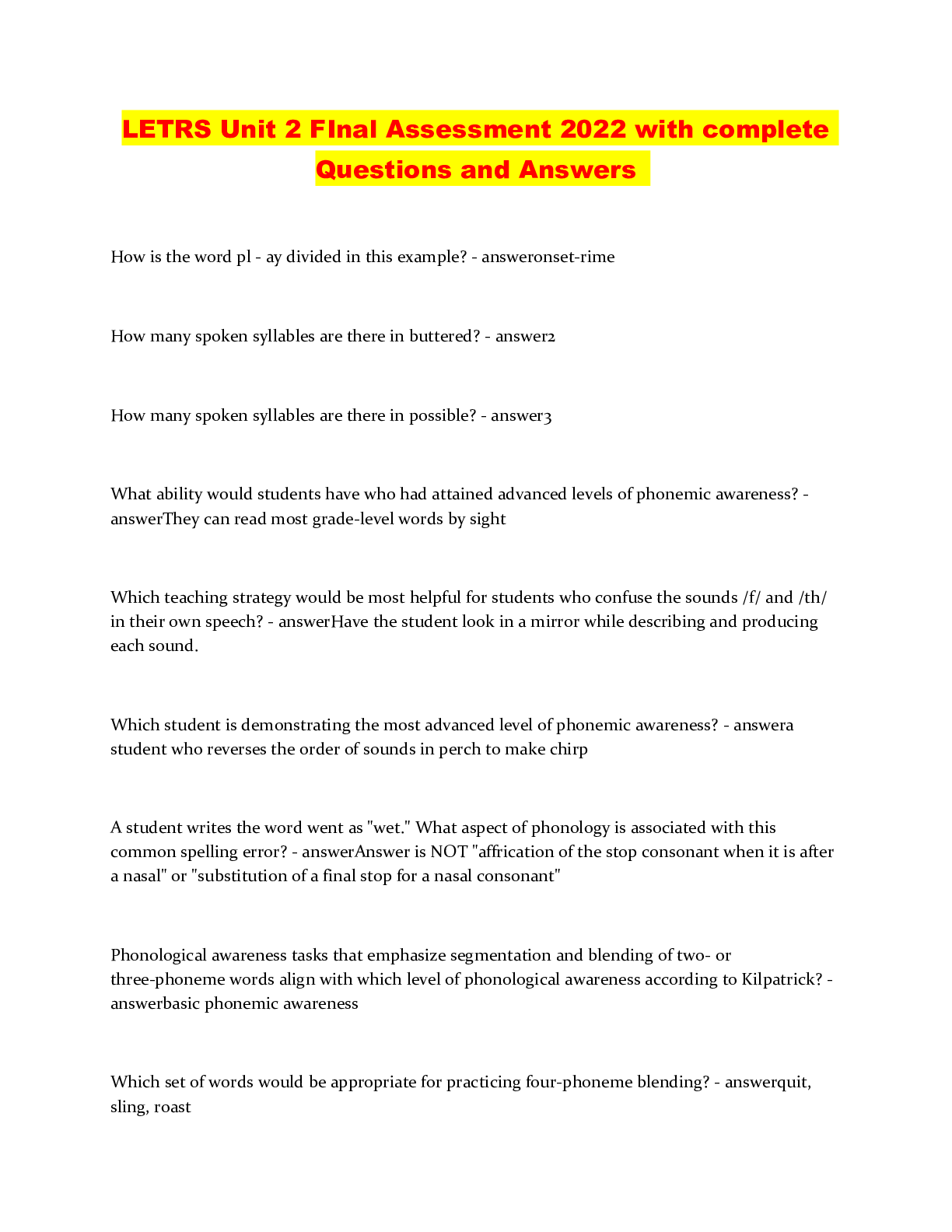*NURSING > QUESTIONS & ANSWERS > APEA Ortho Questions and Answers Download to Boost your Grades (All)
APEA Ortho Questions and Answers Download to Boost your Grades
Document Content and Description Below
A tool for assessing risk factors for osteoporotic fractures is the: DEXA.FRAX. CorrectBRCA1.HAARM. Incorrect Explanation: The FRAX calculator generates fracture risk based on age, body mass index,... parental fracture history, use of glucocorticoids, presence of rheumatoid arthritis or secondary osteoporosis, and tobacco and alcohol use. It has been validated for black, Hispanic, and Asian women in the USA and has calculators that are country and continent specific. Duel energy x-ray absorptiometry, DEXA, is the optimal standard for measuring bone density. BRAC1 is a gene that can mutate and increase the risk of breast cancer. HAARM is the melanoma risk model. Question: Anserine bursitis arises from: excessive running. Correctexcessive kneeling. Incorrectarthritis.trauma Explanation: Anserine bursitis arises from excessive running, valgus knee deformity, fibromyalgias, and osteoarthritis. Prepatellar bursitis (“housemaid’s knee”) arises from excessive kneeling. A popliteal or “baker’s” cyst arises from distention of the gastrocnemius semimembranous bursa from underlying arthritis or trauma. Question: When examining the knee, which of the following symptoms could be indicative of a positive Adduction (Varus) Stress Test? Pain in the lateral joint line CorrectPain in the medial joint line IncorrectPain in the anterior joint lineA click along the medial joint line. Explanation: The Adduction (or Varus) Stress Test is a maneuver that evaluates the function of the lateral collateral ligament. To perform this test, the knee is held in 30 degrees of flexion. With one hand on the medial side of the knee and one hand on the ankle, an adduction force is gently applied. If pain is noted in the lateral joint line, this could be indicative of a lateral collateral ligament tear. When tenderness extends more to the proximal or distal joint line, the collateral ligament may be the cause of pain instead of the meniscus. Question: When assessing the knee, the examiner instructs the patient to straighten his knee. This motion would assess knee: flexion.extension. Correctinternal rotation.external rotation. Explanation: Having the patient straighten his leg assesses extension of the knee. The examiner instructs the patient to bend his knee. This maneuver assesses knee flexion. Internal rotation of the knee could be elicited by having the patient swing his lower leg toward the midline while sitting. Instructing the patient to swing his leg away from his midline while sitting assesses external rotation of the knee. Question: When performing an examination of a tender left finger on an adult, the surrounding tissue reveals warmth, edema, and redness. This finding could be suggestive of: carcinoma.muscular atrophy. synovitis. Incorrectgouty arthritis. Correct Explanation: Redness, warmth, and edema over a tender joint suggest septic or gouty arthritis infection, or possibly rheumatoid arthritis. Question: An example of a fibrous joint would be the: vertebral bodies of the spine.skull. Correctshoulder. Incorrectpubic symphysis of the pelvis. Explanation: The skull is an example of the fibrous joint. Examples of synovial joints include the shoulder, knee, hip, wrist, distal radioulnar, elbow, and carpals. Vertebral bodies of the spine and the pubic symphysis of the pelvis are examples of cartilaginous joints. Question: To palpate the medial meniscus, slightly internally rotate the tibia and palpate the medial soft tissue along the: lateral joint line of the knee.on either side of the patella.upper edge of the tibial plateau. Correcttop of the patella. Explanation: To palpate the medial meniscus, slightly internally rotate the tibia and palpate the medial soft tissue along the upper edge of the tibial plateau. The lateral meniscus is palpated on the lateral joint line by placing the patient's knee in slight flexion. To palpate the tibiofemoral joint, face the patient's knee and place the thumbs in the soft-tissue depressions on either side of the patellar tendon. Question: A patient complains of a sharp burning pain in the neck and right arm with associated paresthesias and weakness. These symptoms may be associated with: mechanical neck pain.mechanical neck pain with whiplash.cervical radiculopathy. Correctcervical myelopathy. Explanation: With cervical radiculopathy, nerve root compression is the etiology. Symptoms may include sharp burning or tingling pain in the neck and one arm with associated paresthesias. Mechanical neck pain is described as aching pain in the cervical paraspinal muscles and ligaments with associated muscle spasm and stiffness and tightness in the upper back and shoulder, lasting up to 6 weeks. In patients with mechanical neck pain with whiplash, the paracervical pain and stiffness begins the day after injury and may be accompanied by occipital headaches, dizziness, and malaise. In cervical myelopathy, cervical cord compression, the neck pain is associated with bilateral weakness and paresthesias in both upper and lower extremities. Question: A patient complains of lateral hip pain while pointing near the trochanter. This type of pain could be suggestive of: sciatica. Incorrectradicular pain.polyarticular arthritis.bursitis. Correct Explanation: Lateral hip pain near the greater trochanter suggests trochanteric bursitis. Sciatica symptoms usually include a shooting pain below the knee, commonly in the lateral leg or posterior calf and accompanied by low back pain. Radicular pain refers to pain that radiates along the dermatome of a nerve due to inflammation or irritation of a nerve root, as with sciatica pain. Polyarticular arthritis refers to arthritis involving several joints. Question: The muscle of the scapulohumeral group that crosses the glenohumeral joint posteriorly and inserts on the greater tubercle is known as the: infraspinatus muscle. Correctpectoralis major. subscapularis muscle. Incorrectsupraspinatus muscle. Explanation: One of the muscles of the scapulohumeral group that crosses the glenohumeral joint posteriorly and inserts on the greater tubercle is the infraspinatus muscle. The other one is the teres minor muscle. The pectoralis major muscle is situated on the anterior chest. The muscle that runs above the glenohumeral joint and inserts on the greater tubercle is known as the supraspinatus. The subscapularis muscle originates on the anterior surface of the scapula and crosses the joint anteriorly and inserts on the lesser tubercle. Question: Inspection of the hip begins with careful observation of a patient's gait. A patient's foot moves forward without bearing weight. This is known as the: swing phase of gait. Correctstance phase of gait.push off phase of gait.heel strike phase of gait. Explanation: Inspection of the hip begins with careful observation of a patient's gait. There are 2 phases of gait: stance and swing. The swing phase occurs when the foot moves forward and does not bear weight. The stance phase occurs when the foot is on the ground bearing weight. Question: The axioscapular group of muscles: pulls the shoulder backward. Correctrotates the shoulder laterally.produce internal rotation of the shoulder. Incorrectdraws the shoulder blade forward. Explanation: The axioscapular group pulls the shoulder backward and rotates the scapula. The scapulohumeral group of muscles rotates the shoulder laterally, including the rotator cuff, and depresses and rotates the head of the humerus. The axiohumeral group produces internal rotation of the shoulder. The serratus anterior draws the shoulder blade forward. Question: When assessing the knee, the examiner instructs the patient to sit and swing his lower leg toward midline. This motion assesses knee: flexion.extension.internal rotation. Correctexternal rotation. Explanation: Internal rotation of the knee is elicited by having the patient swing his lower leg toward the midline while sitting. Instructing the patient to bend his knee assesses knee flexion. Having the patient straighten his leg assesses extension of the knee. Instructing the patient to swing his leg away from his midline while sitting would be a maneuver to assess external rotation of the knee. Question: When performing a musculoskeletal examination, the nurse practitioner instructs the patient to move his arm in front of his body. This motion of the shoulder girdle would be an example of: adduction. Incorrectabduction.flexion. Correctextension. Explanation: When performing a musculoskeletal examination, the nurse practitioner instructs the patient to move his arm in front of his body. This motion of the shoulder girdle would be an example of flexion. Extension occurs when the patient moves his arm behind himself. Abduction occurs when the patient moves his arm away from the body laterally and overhead. Adduction occurs when the patient moves his arm across his body. Question: Static stabilizers of the shoulder are referred to as those structures that are: muscular structures of the shoulder girdle.capable of movement. bony structures of the shoulder girdle. Correctresponsible for stabilizing the humeral head in the glenoid cavity. Incorrect Explanation: Static stabilizers are incapable of movement and include the bony structures of the shoulder girdle, the labrum, the articular capsule, and the glenohumeral ligaments that add to joint stability. Dynamic stabilizers are capable of movement and include the SITS muscles of the rotator cuff (supraspinatus, infraspinatus, teres minor, and subscapularis). These muscles move the humerus and compress and stabilize the humeral head within the glenoid cavity. Question: To test the thumb for abduction, ask the patient to: move his thumb across his palm and touch the base of the fifth finger. Incorrectmove his thumb from the base of the fifth finger and then as far away from the palm as possible.touch the thumb to each of the other fingertips. place the fingers and thumbs in the neutral position with the palm up and then move the thumb anteriorly away from the palm. Correct Explanation: Placing the fingers and thumbs in the neutral position with the palm up and moving the thumb anteriorly away from the palm assesses abduction. To test the thumb for flexion, ask the patient to move his thumb to touch the base of the fifth finger. To test extension, ask the patient to move his thumb from the base of the fifth finger, across the palm, and then as far away from the palm as possible. Touching the thumb to each of the other fingers tests opposition. Moving the thumb back to its neutral position assesses adduction. Question: Passive flexion, valgus stress, and internal rotation of the lower leg, evaluates the: medial meniscus.lateral meniscus. Correctlateral collateral ligament (LCL). Incorrectposterior cruciate ligament (PCL). Explanation: Passive flexion, valgus stress, and internal rotation of the lower leg, evaluates the lateral meniscus. Question: The nurse practitioner instructs the patient to lie supine, bend his knee, and turn his lower leg and foot away from the midline. This maneuver would assess hip: abductionextension.external rotation. Incorrectinternal rotation. Correct Explanation: To assess for hip internal rotation, the patient would lie supine, bend his knee, and turn his lower leg and foot away from the midline. To assess hip abduction, the patient would lie supine and move his lower leg away from the midline. To assess hip extension, the patient would lie face up, bend his knees, place feet flat on the table, and lift his buttocks off the table. To assess for external rotation of the hip, the patient would lie supine, bend his knee, and turn the lower leg and foot toward the midline. Question: Children with Legg-Calve Perthes disease should: [Show More]
Last updated: 1 year ago
Preview 1 out of 20 pages
Instant download
.png)
Instant download
Reviews( 0 )
Document information
Connected school, study & course
About the document
Uploaded On
Aug 03, 2021
Number of pages
20
Written in
Additional information
This document has been written for:
Uploaded
Aug 03, 2021
Downloads
0
Views
81

.png)
.png)
.png)
.png)
.png)
.png)
.png)
.png)
.png)
.png)
.png)

.png)

.png)
.png)












